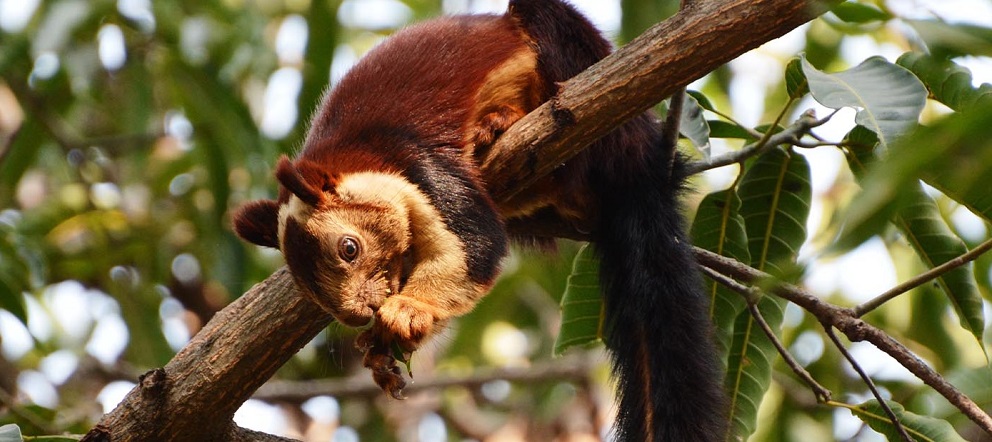Did you know that the Satpura National Park is the only national park in Madhya Pradesh where you can get to see the Indian Giant Squirrel? We call this specie the Indian Giant Squirrel or the Malabar Giant Squirrel or also, the Nanhi our Mascot. They are the funky range of the weirdly attractive rodent in all colors like red, black, orange, or brown jumping from one tree to another! These are athletic species and jump up to 20 feet. The Indian Giant Squirrel is well known for its vivid coat and is three feet long from tip to tail. It is a big squirrel with large and powerful claws and panda-like giant ears, red wine upper body, and a creamy white underpart with a reddish brown tail with a white tip which helps them to balance their agile body.
The Indian Giant Squirrel is an arboreal species and is found throughout the Satpura tiger reserve. They are generally found in tall trees and are found either in pairs or solitary as they are quite territorial. They are more active during the mornings and the late evenings. A Pair can make several nests in an area and some of them are even used as a nursery while some are used as the roosting place or can also be used to fool the predators. They are highly skilled in eating their food hanging upside down.
Subspecies of Indian Giant Squirrel
Spread across the Southern and Central states, there are four species of the Indian or the Malabar Giant Squirrel native to India.
1. Ratufa Indica in the North and the central Western Ghats which can be best sighted in Nilgiris in Tamil Nadu. Their back is maroon with a light, pale-colored tail and face.
2. Ratufa Indica Maxima in the Southern Western Ghats which can be best sighted in Kerala. Comparably, a larger version with a dark tail, shoulder, and back.
3. Ratufa Indica Centralis is the Eastern and Central India which can be best seen in Satpura and Eastern ghats and are generally smaller in size. They don’t possess a pale tail but rather a darker tail and back.
4. Ratufa Indica Dealbata in Southern Gujarat is the rarest of all other subspecies. It is pale brown as compared to its counterparts and has a creamy whitish tail and they are now hardly sighted in Gujarat.
Interesting Facts about Indian Giant Squirrel
1. The Giant Squirrel is pondered as the index of the good health of the forest.
2. They sound just similar to the sound of the toy gun.
3. Mostly they feed on fruits and insects.
4. In case of any danger, they lie flat against the branch and freeze, in a hope that they are not getting noticed.
5. To avoid predators, they build their nests high up in the trees.
6. Unlike the other squirrels, they live a solitary life and usually come together for mating purpose.
7. The Emblem of Satpura National Park also features the Giant squirrel and being an indicator of a healthy ecosystem, the national park has used the squirrel in its logo.
Where to Spot these species in Madhya Pradesh?
To observe this giant squirrel in the wild, you must head to Satpura National Park and look high up in the trees. The Special feature of the Satpura National Park is this squirrel. Being a part of the unique ecosystem, Satpura National Park is very rich in biodiversity and hence, these squirrels get a diverse variety of trees to nest and feed on.
The National Park being an ideal habitat provides the visitors with a good opportunity for sightings. Due to the variation in their colors, sometimes it is difficult to differentiate between them.
Since these species need big trees and woodlands, we have to protect these woodlands otherwise we will lose the habitat of this majestic specie.




